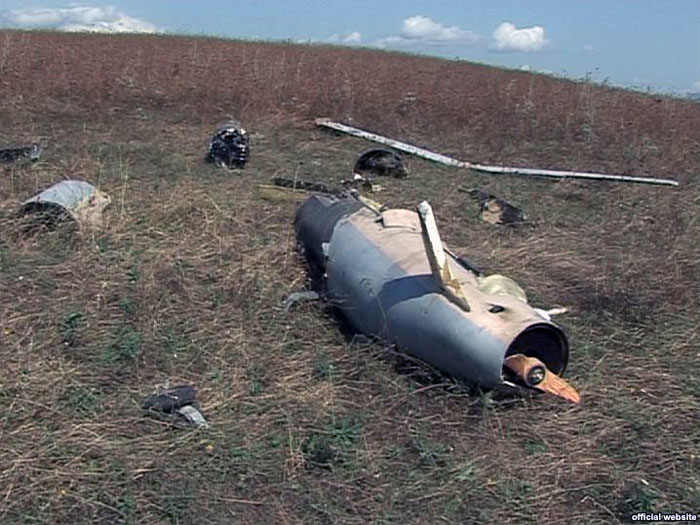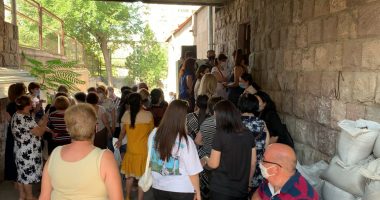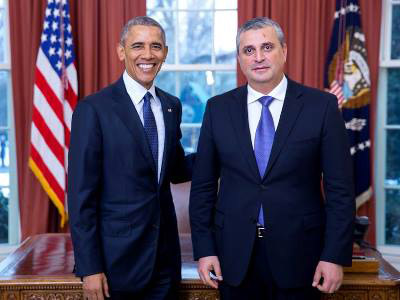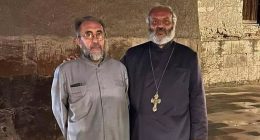Joseph Dagdigian
Harvard, MA


The foundation of Yerevan is often cited as 782 B.C., the year the Urartun city of Erebuni was founded by Argishti I on a hill within the borders of the modern city of Yerevan. While Yerevan may be considered the direct descendant of Erebuni, mankind has lived there for many thousands of years before King Argishti I built his city.
Visitors arriving at Yerevan’s Zvartnots airport pass the U.S. Embassy on the way to Yerevan’s center. In back of the embassy is a small, man made lake. Rising above the lake’s opposite shore is the Shengavit Historical and Archeological Culture Preserve. Within the preserve are excavations revealing settlements from the end of the 4th to the beginning of the 2nd millennium B.C., as well a small museum containing artifacts found at the site. The neatly arranged artifacts are labeled in English, Armenian, and Russian. The actual archeological site spans an area of 6 hectares (about 15 acres), though during the Soviet era a hospital was built over part of the site destroying forever the yet unexamined archeological evidence underneath.
The Shengavit archeological record contains 4 layers, each about 4 meters (12 feet) in depth representing distinct phases of habitation. The lowest and oldest layer contains the archeological record of inhabitants living around 4000 – 3000 B.C., while the uppermost, most recent layer is dated to about 2000 B.C. Scholars believe the site was continually inhabited for over 2000 years. Found within the oldest stone age layer were crude stone tools and other items, while the upper layer revealed sophisticated pottery, the presence of agricultural activity, cattle raising, and copper tools as well as stone molds used to cast copper implements. Buildings were constructed of unbaked clay bricks set upon stone foundations with connected circular and rectangular rooms. The inside walls of the rooms were plastered. There was evidence that the walls were painted, though that evidence no longer exists. Within the rooms were found triangular hearths set upon stands. The circular rooms contained centrally located stone pedestals upon which columns rested to support the roof. Floors were made of pebbles covered with clay.
The Shengavit culture was spread throughout the Ararat valley and was influential as far as western Armenia, Cilicia, northern Mesopotamia, and Palestine. Obsidian tools from Armenia were found in the Middle East. Anthropologists, analyzing human remains from Shengavit tombs, believe the “Armenoid” skull type typical of current day Armenians evolved in this region. Shengavit was linked to other settlements in the region, all of which demonstrated a similar culture and were connected by trade. While there is no record of the language used at the time, scientists believe that a non-Semitic, non-Indo-European language or family of languages was prevalent, traces of which remain today within the Armenian language.
While it can not be stated that the early residents of Shengavit were “Armenian”, as the Armenian nation, people, and language may not have been formed at that time, it is likely that the tribes living in the region ultimately coalesced to form the Armenian people and the Armenian language. At a much later time migrating tribes introduced Indo-European elements into the Armenian language.
Initial excavation of the site began in 1936 by Joseph Orbeli (1887-1961) and Eugeni Bayburtyan (1898-1938) and lasted for 2 years; then the site was abandoned. Orbeli was the director of the Hermitage Museum in St. Petersburg, Russia. Bayburtyan apparently was a bit too nationalistic; he was arrested by Stalin and was never seen again. From 1945-1950 Sandro Sardaryan (1912-1995) studied the site and then, from 1950-1983, led a new excavation of Shengavit. Yuli Tamanyan, being an architect and member of the excavating team, performed the site’s measurements. He was the son of famed architect Alexander Tamanian who, in 1925, developed the general layout of Yerevan. In 1967 Sardaryan published a study “Primitive Society in Armenia” in English describing Shengavit and other ancient settlements within the Armenian highlands.
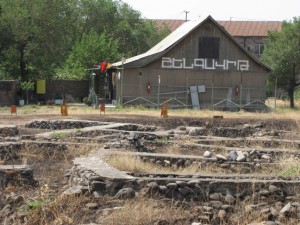

Currently on the Shengavit preserve one may view the foundations of ancient dwellings and visit Shengavit’s nicely arranged museum. The director of the “Shengavit Historical and Archaeological Culture Preserve” is Vladimir Tshagharyan, an experienced archeologist and architect with considerable experience in managing and preserving Armenia’s large number of historical and archaeological sites. He is assisted by Vano, an experienced construction worker, and Gayane – a guide who is fluent in Armenian, English, Russian, and perhaps a few other languages. The 3 person staff is severely underpaid, receiving salaries that are impossible to live on in Armenia. They are, in effect, volunteers as their motivations are the preservation of Armenia’s important historical and archaeological record. In addition to inadequate pay, there is zero budget (not an exaggeration – it’s actually zero!) for the maintenance and renovation of the site. The site desperately needs to install running water (there is no water at the site), a sewage line (there is none), rest rooms, and a phone line (there is none). They need a dozen or so boards to repair the benches (they were denied $100-150 needed for the bench repairs by the head of Yerevan’s Shengavit district – there are budgetary constraints!). The museum building dates from 1920 when it was constructed to serve as a station for Red Army officers. The roof needs repair and the museum walls need reinforcement in order to support the used air conditioners which were donated to the museum.
My wife and I spent a day visiting building supply stores where we bought enough material to start the most critical repairs before the arrival of winter weather. The staff does all the repair and maintenance work, including digging trenches for a sewer line and for a water connection. Part of the preserve was illegally sold to a private individual. The director has gathered extensive documentation on this illegal sale and presented the evidence to Yerevan City Hall. He is assured that the matter will be rectified. If it is not, he says, he will go to court – though hiring a lawyer will require funds which he does not have. If it comes to this, and one hopes it won’t, the Diaspora will need to help. Moreover the site is not fenced in. I visited the site on two consecutive days. On the second day a new pile of trash had been dumped on the site. Fortunately there is a policeman stationed at the site during off hours to protect the valuable artifacts in the museum and the undiscovered ones which still lie underground.
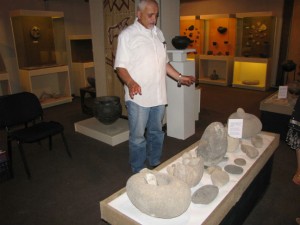

This is an important site not just for the study of the formation of the Armenian nation, but for studying the ancient history and culture of the entire region. This past summer a group of American archeologists from Pennsylvania were researching the site until the really hot weather arrived, at which point they returned home. They plan to return once the weather cools down a bit. It is embarrassing for foreign visitors to see that such an important site is so severely underdeveloped and ignored, except for the few people who are desperately trying to maintain it. Of course there are severe financial shortages in Armenia, but a recent U.N. survey indicated that Yerevan has more expensive cars per capita than any other major city!
Vladimir “Vova” Tshagharyan, Shengavit’s director, has ambitions to establish the amenities needed by visitors. The site needs to be secured with a fence surrounding the area. The illegally sold land must be returned. The antiquated museum building needs to be renovated and ultimately replaced with a more modern facility with a library, an area to study and preserve artifacts, and an area where visiting archeologists can conduct their research. Shengavit’s director is considering the establishment of a non-profit organization or an NGO to oversee donations to the site.
The Shengavit Historical and Archaeological Culture Preserve is only a 15-20 minute taxi drive from the center of Yerevan. Its entrance is in back of the Shengavit hospital on Bagratunyats Street, on the opposite side of Yerevan Lake from the U.S. embassy. Visitors are welcome throughout the week other than on Mondays when most museums in Armenia are closed.
References:
• http://www2.widener.edu/~msrothma/shengavitweb2.html
• Primitive Society in Armenia, Sandro Sardaryan, MITK Publishing House, 1967, Armenia

